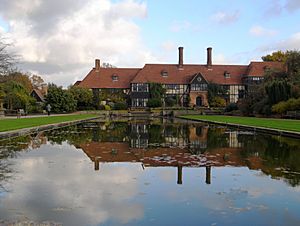Frederick Keeble facts for kids
Quick facts for kids
Sir Frederick Keeble
|
|
|---|---|
| Born | 2 March 1870 Westminster, England
|
| Died | 19 October 1952 (aged 82) Royal Borough of Kensington and Chelsea, London, England
|
| Citizenship | British |
| Education | Alleyn's School Dulwich College |
| Alma mater | Gonville and Caius College, Cambridge |
| Spouse(s) | Mathilde Marie Cécile Maréchal (1898 to 1915; her death) Lillah McCarthy (1920 to 1952; his death) |
| Children | One daughter |
| Awards | Fellow of the Royal Society (1913) Commander of the Order of the British Empire (1917) Knight Bachelor (1922) |
| Scientific career | |
| Fields | Biology Botany |
| Institutions | Victoria University of Manchester University College, Reading University of Oxford Royal Institution |
Sir Frederick William Keeble (born March 2, 1870 – died October 19, 1952) was a British biologist and plant scientist. He was also a university professor and a science advisor. He was known for his work with plants. He taught at the University of Oxford and the Royal Institution.
Contents
Early Life and Education
Frederick Keeble was born in Westminster, London, England, in 1870. He was one of six sons. His father owned a furniture company. Frederick went to two schools in London: Alleyn's School and Dulwich College.
After school, he studied natural sciences at Gonville and Caius College, Cambridge. He did very well in his studies, earning high marks. In 1893, he graduated from the University of Cambridge. He then went to Germany to study botany (the study of plants) with a famous scientist named Wilhelm Pfeffer.
Frederick Keeble's Career
Starting in Academia
In 1894, Frederick Keeble traveled to Ceylon (now Sri Lanka). There, he researched how plants work, especially tropical trees. He was interested in how some trees' leaves hung down. He wrote two important papers about his findings in 1895.
When he returned to the UK, he taught botany at Owens College, Manchester (part of Victoria University). He also taught at the University College of Wales, Aberystwyth for a short time.
In 1902, he joined University College, Reading. He started as a lecturer in botany. Later that year, he became the director of the horticulture department. Horticulture is the art and science of growing plants. By 1907, he became a full professor. He also led the Faculty of Science for a few years. During his time at Reading, he worked with other scientists and published more papers. In 1910, he visited universities in Canada and the USA. He wanted to learn new ways to teach about farming and plants.
In 1914, he became the Director of the Royal Horticultural Society's gardens in Wisley, Surrey. This was a very important role in the world of plants and gardening.
Helping During World War I
When World War I began in 1914, Frederick Keeble quickly joined the Board of Agriculture and Fisheries. His job was to help the country produce more food.
In 1917, a new department was created to focus on food production. He became the Controller of Horticulture. This meant he was in charge of growing fruits, vegetables, and flowers for the country. He wrote an article in The Times newspaper, telling people how to grow potatoes at home. This was part of a big effort to increase food supplies. He also helped create groups of "patriotic gardeners." These experienced gardeners traveled around, giving advice to schools and communities on how to grow more food.
In 1919, he became an Assistant Secretary at the Board of Agriculture. He played a key role in setting up the East Malling Research Station. This station became an important place for studying how to grow plants better.
Returning to Universities
In 1920, Frederick Keeble went back to teaching. He became the Sherardian Professor of Botany at the University of Oxford. This was a very respected position. He bought land near Oxford and built a home with a large garden. He used his garden for his plant research and for hosting guests.
Later, in 1927, he left Oxford to work for a company called Imperial Chemical Industries (ICI). He became their agricultural adviser. He worked with a team to study how fertilizers helped plants grow better on farms and pastures. This research was published in 1932. He continued to advise ICI as a scientific expert.
In 1938, he returned to academia one last time. He became the Fullerian Professor of Physiology at the Royal Institution. He retired from this role in 1941.
Later Life and Achievements
Frederick Keeble retired in 1941. He first moved to Cornwall, then later to London. He passed away in his London home on October 19, 1952.
He received many honors for his work. In 1913, he was made a Fellow of the Royal Society (FRS). This is a very high honor for scientists in the UK. He also led the botany and agricultural sections of the British Association. In 1924, he became a member of the Royal Institution.
For his important work during World War I, he was awarded the Commander of the Order of the British Empire (CBE) in 1917. In 1922, he was made a Knight Bachelor by King George V. This meant he could use the title "Sir" before his name.


